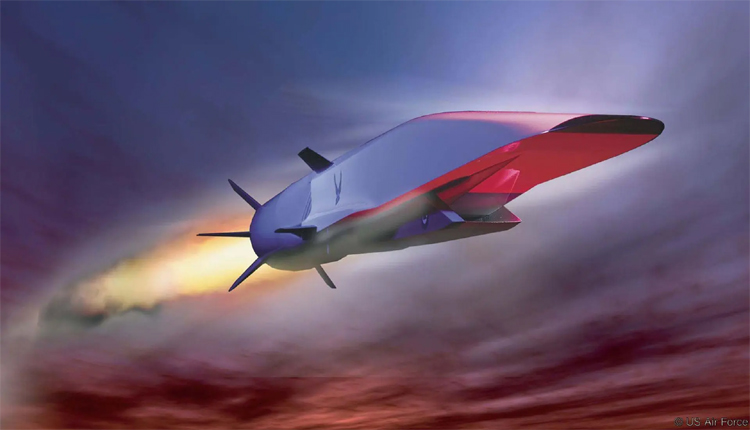Hyderabad: India is reportedly working on a hypersonic glide vehicle (HGV) missile system code-named ‘Dhvani’, which will soon be inducted into the national arsenal.
Scheduled to be built by the Defence Research and Development Organisation (DRDO), the ‘Dhvani’ missile is a boost-glide system capable of reaching speeds of up to Mach 21 or around 25,000 km/h. The speed of ‘Dhvani’ is 21 times the speed of sound. At its operational altitude, the missile can glide to its target at hypersonic speeds, making it hard to track on enemy radars and ballistic missile defences (BMDs) because of the sharp manoeuvres the missile makes during flight. Expected to have a range of over 5,500 km, ‘Dhvani’ would qualify it as an intercontinental ballistic missile (ICBM), putting it in a class of missiles which can target all of Asia, Europe and part of North America.
DRDO is building the ‘Dhvani’ missile under its Advanced Systems Laboratory (ASL) at its facility in Hyderabad. Highlights of the ‘Dhvani’ missile include the ‘blended wing-body configuration’ that makes it less detectable by radars, its manoeuvrability that makes it difficult to intercept and its heat protection system that allows it to withstand up to 3,000°C that the missile’s body might reach due to atmospheric friction when flying at hypersonic speeds. Another highlight of the missile is that it has the capacity to carry both conventional and nuclear warheads.
“The ‘Dhvani’ HGV can glide at speeds of up to Mach 21 and has a range of over 5,500 km.” DRDO Principal Controller Dr Praveen Kumar told the media. “We have successfully conducted several ground tests on the complete missile configuration and are making final preparations for a trial launch.” According to Rajnath Singh, the minister of defence, the ‘Dhvani’ missile “will strengthen our strategic deterrence and showcase our technological prowess in missile systems”. “The induction of ‘Dhvani’ into the Indian Armed Forces will take place by 2029-30,” Rajnath Singh added. “India is determined to further strengthen its defence capabilities by developing state-of-the-art systems like ‘Dhvani’.”
From February 28 to March 2, 2025, DRDO displayed the full-scale model of the ‘Dhvani’ HGV missile at the ‘Vigyan Vaibhav’ exhibition in Hyderabad. The model missile, described as having a “wave-rider configuration,” was developed under the Hypersonic Technology Innovation Balisada (HTIB) program to optimise the lift-to-drag ratio (L/D) for maximum range and payload. “Wave-rider is a type of HGV,” Dr Kumar explained. “It follows a trajectory that helps it to ride on the shock waves produced by its high-speed movement, resulting in a high L/D ratio, which in turn leads to the maximum range.”
Lt Gen (Retd) Vinod Khandare, a security analyst, commented on the “game-changer” status of the ‘Dhvani’ missile and its induction into the Indian armed forces, noting that “the ‘Dhvani’ HGV makes India an elite member of a club that only a few countries like the United States, Russia, and China are part of.” He continued, “With such hypersonic weapons, India is enhancing its deterrence and ensuring a robust response to emerging threats.” The research and development of ‘Dhvani’ took over eight years.
Before preparing for its inaugural flight, the Indian HGV underwent extensive ground testing. The previous test was in 2023, with further tests in 2024 to work out any remaining technical problems and iron out the missile’s details before it is declared operational. The nuclear-capable Dhvani’ HGV’s expected in-service date is 2030. Compared to ballistic missiles, ‘Dhvani’ can be manoeuvred in flight, making it difficult to shoot down.
India’s ‘Dhvani’ is among a number of HGVs that nations are developing, including China, Russia, the US, France and Germany. Russia refers to it as “Dagger”, while the United States refers to it as “Avangard” and “Hawk-eyed”.
India’s regional security concerns, particularly since the onset of the Iran-Israel conflict, are driving the ‘Dhvani’ HGV project, leading to heightened geopolitical tensions. The successful flight test will offer “capability-based deterrence”, enabling India to bolster its military arsenal to match other nations and prevent adversaries from surpassing its capabilities.
However, ‘Dhvani’ does have a few downsides. Hypersonic missiles like ‘Dhvani’ are expensive and come with unique challenges,, such as the integration of a guidance system with existing technologies and high-temperature materials. The Indian Air Force and the Indian Navy would also have to conduct integration tests for the system and related technologies before it becomes operational. One defence expert told ANI that it might take up to 10 years for the ‘Dhvani’ to be fully inducted.



Comments are closed.